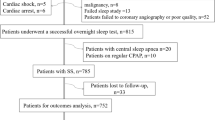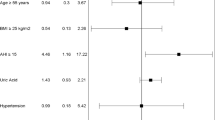Abstract
Obstructive Sleep Apnea (OSA) is strongly associated with adverse cardiovascular events. In these patients, increased oxidative stress has been associated with accelerated coronary atherosclerosis. However, it is unclear if OSA is associated with significant coronary artery plaque burden. Our aim is to determine whether OSA and/or markers of hypoxemia are associated with coronary plaque burden (CPB). Patients who had coronary computed tomography angiography (CCTA) and a polysomnogram within 1 year of each other between 2011 and 2016 were analyzed. Apnea–Hypopnea Index (AHI) and hypoxemic burden (ODI3%, ODI4%, nadir SpO2, average spO2 and time of spO2 < 88%) were obtained from the polysomnogram. Total CPB was assessed using the prognostically validated CT-Leaman score (CT-LeSc). Significant CPB was defined as CT-LeSc ≥ 8.3. There were 119 patients with mean (± SD) age of 59 ± 12 years. Using logistical regression analysis; AHI, ODI4% and ODI3% were the only parameters associated with significant CPB. Severe OSA (AHI ≥ 30 events/h) was associated with significant CPB with adjusted OR of 3.21 (p = 0.010) independent of traditional cardiovascular risk factors. Mechanisms associated with apnea and hypopnea events (as measured by AHI, ODI3% and ODI4%), but not the severity of arterial desaturation (nadir SpO2, burden of SpO2 < 88%) were associated with significant CPB.


Similar content being viewed by others
References
Senaratna CV, Perret JL, Lodge CJ, Lowe AJ, Campbell BE, Matheson MC et al (2017) Prevalence of obstructive sleep apnea in the general population: a systematic review. Sleep Med Rev 34:70–81
Shahar E, Whitney CW, Redline S, Lee ET, Newman AB, Nieto FJ et al (2001) Sleep-disordered breathing and cardiovascular disease: cross-sectional results of the Sleep Heart Health Study. Am J Respir Crit Care Med 163(1):19–25
Marin JM, Carrizo SJ, Vicente E, Agusti AG (2005) Long-term cardiovascular outcomes in men with obstructive sleep apnoea-hypopnoea with or without treatment with continuous positive airway pressure: an observational study. Lancet 365(9464):1046–1053
Bakker JP, Edwards BA, Gautam SP, Montesi SB, Duran-Cantolla J, Aizpuru F et al (2014) Blood pressure improvement with continuous positive airway pressure is independent of obstructive sleep apnea severity. J Clin Sleep Med 10(4):365–369
Montesi SB, Edwards BA, Malhotra A, Bakker JP (2012) The effect of continuous positive airway pressure treatment on blood pressure: a systematic review and meta-analysis of randomized controlled trials. J Clin Sleep Med 8(5):587–596
McEvoy RD, Antic NA, Heeley E, Luo Y, Ou Q, Zhang X et al (2016) CPAP for prevention of cardiovascular events in obstructive sleep apnea. N Engl J Med 375(10):919–931
Peker Y, Glantz H, Eulenburg C, Wegscheider K, Herlitz J, Thunström E (2016) Effect of positive airway pressure on cardiovascular outcomes in coronary artery disease patients with nonsleepy obstructive sleep apnea: The RICCADSA Randomized Controlled Trial. Am J Respir Crit Care Med. 194(5):613–620
Somers VK, Dyken ME, Clary MP, Abboud FM (1995) Sympathetic neural mechanisms in obstructive sleep apnea. J Clin Investig 96(4):1897–1904
Somers VK, White DP, Amin R, Abraham WT, Costa F, Culebras A, et al. Sleep Apnea and Cardiovascular Disease. American Heart Association/American College of Cardiology Foundation Scientific Statement From the American Heart Association Council for High Blood Pressure Research Professional Education Committee, Council on Clinical Cardiology, Stroke Council, and Council on Cardiovascular Nursing In Collaboration With the National Heart, Lung, and Blood Institute National Center on Sleep Disorders Research (National Institutes of Health) 008;118(10):1080–1111
Punjabi NM, Newman AB, Young TB, Resnick HE, Sanders MH (2008) Sleep-disordered breathing and cardiovascular disease: an outcome-based definition of hypopneas. Am J Respir Crit Care Med 177(10):1150–1155
Meijboom WB, van Mieghem CAG, Mollet NR, Pugliese F, Weustink AC, van Pelt N et al (2007) 64-slice computed tomography coronary angiography in patients with high, intermediate, or low pretest probability of significant coronary artery disease. J Am Coll Cardiol 50(15):1469–1475
Mushtaq MS, De Araujo Gonçalves LP, Garcia-Garcia MH, Pontone WG, Bartorelli WA, Bertella WE, et al. Long-term prognostic effect of coronary atherosclerotic burden: validation of the computed tomography-leaman score. Circulation. 2015;8(2):e002332-e
Andreini D, Pontone G, Mushtaq S, Gransar H, Conte E, Bartorelli AL et al (2017) Long-term prognostic impact of CT-Leaman score in patients with non-obstructive CAD: results from the coronary CT angiography evaluation For clinical outcomes international multicenter (CONFIRM) study. Int J Cardiol 231:18–25
Andrade L, Paiva T (2018) Ambulatory versus laboratory polysomnography in obstructive sleep apnea: comparative assessment of quality, clinical efficacy, treatment compliance, and quality of life. J Clin Sleep Med 14(8):1323–1331
Chou KT, Chang YT, Chen YM, Su KC, Perng DW, Chang SC et al (2011) The minimum period of polysomnography required to confirm a diagnosis of severe obstructive sleep apnoea. Respirology 16(7):1096–1102
Iber CA-IS, Chesson AL, Quan SF. The AASM manual for the scoring of sleep and associated events: rules, terminology, and technical specifications 2007
Berry RB BR, Gamaldo CE, Harding SM, Lloyd RM, Marcus CL and Vaugn BV. The AASM manual for the scoring of sleep and associated events: rules, terminology and technical specifications, Version 2.02012. www.aasmnet.org
Grundy SM, Arai H, Barter P, Bersot TP, Betteridge DJ, Carmena R et al (2014) An International Atherosclerosis Society Position Paper: Global recommendations for the management of dyslipidemia-Full report. Journal of Clinical Lipidology. 8(1):29
Jacobson TA, Ito MK, Maki KC, Orringer CE, Bays HE, Jones PH et al (2015) National lipid association recommendations for patient-centered management of dyslipidemia: part 1–full report. Journal of clinical lipidology. 9(2):129
Abbara S, Arbab-Zadeh A, Callister TQ, Desai MY, Mamuya W, Thomson L et al (2009) SCCT guidelines for performance of coronary computed tomographic angiography: A report of the Society of Cardiovascular Computed Tomography Guidelines Committee. Journal of Cardiovascular Computed Tomography. 3(3):190–204
Abbara S, Blanke P, Maroules CD, Cheezum M, Choi AD, Han BK et al (2016) SCCT guidelines for the performance and acquisition of coronary computed tomographic angiography: A report of the society of Cardiovascular Computed Tomography Guidelines Committee: Endorsed by the North American Society for Cardiovascular Imaging (NASCI). Journal of cardiovascular computed tomography. 10(6):435
Wong DTL, Soh SY, Ko BSH, Cameron JD, Crossett M, Nasis A et al (2014) Superior CT coronary angiography image quality at lower radiation exposure with second generation 320-detector row CT in patients with elevated heart rate: a comparison with first generation 320-detector row CT. Cardiovascular Diagnosis and Therapy. 4(4):299–306
Nerlekar N, Ko BS, Nasis A, Cameron JD, Leung M, Brown AJ et al (2017) Impact of heart rate on diagnostic accuracy of second generation 320-detector computed tomography coronary angiography. Cardiovasc Diag Ther 7(3):296–304
Raff GL, Chair A, Abidov S, Achenbach DS, Berman LM, Boxt MJ et al (2009) SCCT guidelines for the interpretation and reporting of coronary computed tomographic angiography. J Cardiovasc Compu Tomogr 3(2):122–136
Leipsic J, Abbara S, Achenbach S, Cury R, Earls JP, Mancini GBJ et al (2014) SCCT guidelines for the interpretation and reporting of coronary CT angiography: A report of the Society of Cardiovascular Computed Tomography Guidelines Committee. Journal of Cardiovascular Computed Tomography. 8(5):342–358
de Araujo Goncalves P, Garcia-Garcia HM, Dores H, Carvalho MS, Jeronimo Sousa P, Marques H et al (2013) Coronary computed tomography angiography-adapted Leaman score as a tool to noninvasively quantify total coronary atherosclerotic burden. Int J Cardiovasc Imaging 29(7):1575–1584
Ryan S, Taylor CT, McNicholas WT (2005) Selective activation of inflammatory pathways by intermittent hypoxia in obstructive sleep apnea syndrome. Circulation 112(17):2660–2667
Ip MS, Tse HF, Lam B, Tsang KW, Lam WK (2004) Endothelial function in obstructive sleep apnea and response to treatment. Am J Respir Crit Care Med 169(3):348–353
Nieto FJ, Herrington DM, Redline S, Benjamin EJ, Robbins JA (2004) Sleep apnea and markers of vascular endothelial function in a large community sample of older adults. Am J Respir Crit Care Med 169(3):354–360
Jelic S, Padeletti M, Kawut SM, Higgins C, Canfield SM, Onat D et al (2008) Inflammation, oxidative stress, and repair capacity of the vascular endothelium in obstructive sleep apnea. Circulation 117(17):2270–2278
Sorajja D, Gami AS, Somers VK, Behrenbeck TR, Garcia-Touchard A, Lopez-Jimenez F (2008) Independent association between obstructive sleep apnea and subclinical coronary artery disease. Chest 133(4):927–933
Kent BD, Garvey JF, Ryan S, Nolan G, Dodd JD, McNicholas WT (2013) Severity of obstructive sleep apnoea predicts coronary artery plaque burden: a coronary computed tomographic angiography study. Eur Respir J 42(5):1263–1270
Drager LF, Bortolotto LA, Lorenzi MC, Figueiredo AC, Krieger EM, Lorenzi-Filho G (2005) Early signs of atherosclerosis in obstructive sleep apnea. Am J Respir Crit Care Med 172(5):613–618
Turmel J, Sériès F, Boulet L-P, Poirier P, Tardif J-C, Rodés-Cabeau J et al (2009) Relationship between atherosclerosis and the sleep apnea syndrome: an intravascular ultrasound study. Int J Cardiol 132(2):203–209
Lavie L (2015) Oxidative stress in obstructive sleep apnea and intermittent hypoxia–revisited–the bad ugly and good: implications to the heart and brain. Sleep Med Rev 20:27–45
Buda AJ, Pinsky MR, Ingels NB Jr, Daughters GT 2nd, Stinson EB, Alderman EL (1979) Effect of intrathoracic pressure on left ventricular performance. New Engl J Med 301(9):453–459
Romero-Corral A, Somers VK, Pellikka PA, Olson EJ, Bailey KR, Korinek J et al (2007) Decreased right and left ventricular myocardial performance in obstructive sleep apnea. Chest 132(6):1863–1870
Somers VK, Dyken ME, Skinner JL (1993) Autonomic and hemodynamic responses and interactions during the Mueller maneuver in humans. J Auton Nerv Syst 44(2–3):253–259
Hamilton GS, Meredith IT, Walker AM, Solin P (2009) Obstructive sleep apnea leads to transient uncoupling of coronary blood flow and myocardial work in humans. Sleep 32(2):263–270
Hayashi M, Fujimoto K, Urushibata K, Uchikawa S-I, Imamura H, Kubo K (2003) Nocturnal oxygen desaturation correlates with the severity of coronary atherosclerosis in coronary artery disease. Chest. 124(3):936–941
Duce B, Milosavljevic J, Hukins C (2015) The 2012 AASM respiratory event criteria increase the incidence of hypopneas in an adult sleep center population. J Clin Sleep Med 11(12):1425–1431
Acknowledgements
Dr. Edwards is supported by a Heart Foundation of Australia Future Leader Fellowship (101167). Dr Joosten is supported by an NHMRC Early Career Fellowship (1139745). Dr Wong is supported by an NHMRC Early Career Fellowship (1091387).
Funding
None.
Author information
Authors and Affiliations
Corresponding author
Ethics declarations
Conflict of interest
As the corresponding Author, Dennis Wong, for this paper I hereby declare on behalf of all authors that we have no conflicts of interest to disclose.
Ethical approval
All procedures performed in studies involving human participants were in accordance with the ethical standards of the institutional and/or national research committee and with the 1964 Helsinki declaration and its later amendments or comparable ethical standards. This study was a retrospective study involving de-identified information from medical records.
Informed consent
Informed consent was not required as per the institutional ethics committee.
Additional information
Publisher's Note
Springer Nature remains neutral with regard to jurisdictional claims in published maps and institutional affiliations.
Rights and permissions
About this article
Cite this article
Mo, L., Gupta, V., Modi, R. et al. Severe obstructive sleep apnea is associated with significant coronary artery plaque burden independent of traditional cardiovascular risk factors. Int J Cardiovasc Imaging 36, 347–355 (2020). https://doi.org/10.1007/s10554-019-01710-w
Received:
Accepted:
Published:
Issue Date:
DOI: https://doi.org/10.1007/s10554-019-01710-w




